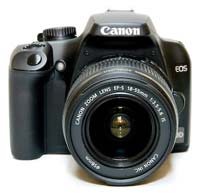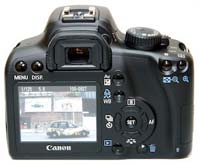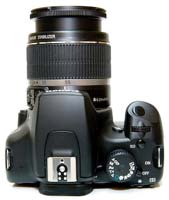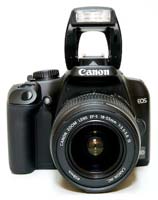Canon EOS 1000D Review
(also called the Canon Digital Rebel XS)
Review Date: August 6th 2008
Author: Mark Goldstein
Leave a comment about this Review
|
Introduction

The Canon EOS 1000D (also known as the Digital Rebel XS) is the new entry-level model in Canon's extensive range of digital SLR camera. The 1000D inherits features from both the more expensive EOS 450D and the older EOS 400D cameras. It has an almost identical body and control layout to its bigger brother, the EOS 450d, whilst sharing the same 10.1 megapixel CMOS sensor, 2.5 inch LCD screen and 3.0fps continuous shooting mode (in JPEG) as the EOS 400D. Canon have carefully downgraded most of the key headline features to differentiate between the 1000D and 450D - 10 and 12 megapixels, 7 and 9 autofocus points, 2.5 and 3 inch LCD screen, 3.0 and 3.5 fps shooting, respectively. On the other hand, the Canon 1000D still has quite a lot in common with the 450D - the same Live View system, with not one but two different modes including contrast detection AF, SD cards instead of CompactFlash, and the EF-S 18-55mm f3.5-5.6 IS kit lens, which should help dispel some of the criticism aimed at Canon for not offering an affordable image stabilisation solution. The Canon EOS 1000D is priced at �499.99 / �649.99 body only and �579.99 / �749.99 / $699 with the 18-55mm IS kit lens. What does all the borrowing and downgrading ultimately add up to? Mark Goldstein tested the Canon EOS 1000D to find out...
Compare Prices
Support PhotographyBLOG: Buy the Canon EOS 1000D from one of our affiliate retailers:Ease of Use
The Canon EOS 1000D is outwardly very similar to its bigger brother, the EOS 450D. It's actually very slightly smaller (126.1 x 97.5 x 61.9 mm), and also slightly lighter in weight at 450g, but the differences are almost imperceptible. The plastic outer shell has the same refined finish and there's a textured area on the hand-grip, but not on the thumb-rest on the rear of the camera. As with the 450D, holding the camera is a little fiddly because the EOS 1000D's comparatively small body size means that the grip isn't particularly deep and people with large hands (like me) may find that their little finger has nowhere to go. The most obvious external difference between the 1000D and the 450D is the smaller 2.5 inch LCD screen, but the vertical row of 5 buttons as found on the EOS 400D have still been removed and dispersed around the rest of the camera. The Canon EOS 1000D looks and feels more expensive than it is actually is, and is certainly solid enough for an entry-level DSLR.
I tested the EOS 1000D with the new EFS 18-55mm f/3.5-5.6 IS kit lens, which offers the same focal range as the standard lens that shipped with the previous 400D model, but crucially adds image stabilisation. This is important for Canon, as competitors like Sony, Olympus and Pentax all offer image stabilisation in their DSLRs. The difference between Canon (and Nikon) and the others is that Sony, Olympus and Pentax have opted for stabilisation via the camera body, rather than the lens, which therefore works with their entire range of lenses. Canon's system is obviously limited by which lenses you choose, but it does offer the slight advantage of showing the stabilising effect through the viewfinder. Canon and Nikon also claim that a lens-based anti-shake system is inherently better too, but the jury's out on that one. Note that both the 1000D and 450D ship with the same kit lens, so you aren't losing out in this respect by opting for the cheaper camera.
Like most entry-level DSLRs, and exactly like the 450D, the EOS 1000D provides a number of auto shooting modes aimed at beginners, including portrait, landscape, close-up, sports and night portrait and flash off choices. All of these functions performed adequately in all aspects, apart from the close-up macro mode that did not come near to offering a true 1:1 reproduction (you'll need a dedicated macro lens for that). There are, of course, manual and semi-automatic modes for users who want more advanced exposure control. Canon refers to these advanced operations as the 'creative zone' and provides all the normal settings including Program, Aperture and Shutter Priority and the full manual mode. Additionally, they provide the 'A-DEP' (Automatic Depth of Field) function that gives a wider depth of field between a near and far subject.
Once the EOS 1000D is in the 'creative zone' users can adjust the ISO setting into one of five positions from 100 to 1600 which is more than adequate for most lighting conditions, although I'm not sure why Canon didn't include an ISO 3200 setting, given the excellent image quality at ISO 1600. The EOS 1000D offers a range of three Auto focus modes (One Shot, AI Focus and AI Servo), and there are six preset, auto and custom white balance options. The viewfinder displays all key exposure information including ISO speed. Key differences between the 1000D and the 450D are the 7-point wide-area AF system (both the 400D and the 450D use a 9-point system). In practice we found little difference between the two systems, with the 1000D being very quick to find focus in almost all situations and subjects, so this certainly isn't a deal-breaker if you're trying to choose between the various models. More disappointing for experienced photographers is the omission of the Spot metering mode, useful in tricky lighting conditions, but we found if most of the EOS 1000D's target audience will miss it, relying instead on the excellent and consistent Evaluative metering system.
 |
 |
| Front | Rear |
Most of the 1000D's buttons are located logically on the rear of the camera, although the removal of the vertical row of 5 buttons as found on the EOS 400D has made the overall layout more complicated. The camera offers quick access to the Continuous modes, Auto Focus, Metering modes and Picture Styles via its circular four-way controller. There's a new ISO button on top of the camera near the aperture/shutter speed control dial, which provides easier access when looking through the viewfinder. Aperture and shutter speed settings can be easily adjusted with the index finger on the well-positioned dial, but it's annoying that you have to hold down the Exposure Compensation button to change the aperture in Manual mode, rather than just press it once to toggle between shutter speed and aperture.
The 1000D inherits the same Live View system as the 450D, so Live View now features on all of Canon's consumer DSLR cameras. If you're new to DSLRs and don't understand the terminology, basically Live View allows you to view the scene in front of you live on the LCD screen, rather than through the traditional optical viewfinder. This is an obvious attraction for compact camera users, who are familiar with holding the camera at arm's length and composing via the LCD screen. It's also appealing to macro shooters, for example, as it's often easier to view the screen than look through the viewfinder when the camera is mounted on a tripod at an awkward angle.
Live View is annoyingly difficult to actually turn on, as Canon have inexplicably buried it in the menu system. Once enabled, Live View is activated by pressing the Set button on the rear of the camera. A grid line display and very useful live histogram can be enabled to help with composition and exposure, and you can zoom in by up to 10x magnification of the image displayed on the LCD screen. Focusing is achieved via the AF / AE Lock button, rather than half-pressing the shutter-button. Live View can also be controlled remotely using the supplied EOS utility software, which allows you to adjust settings and capture the image from a PC.
So who does the EOS 1000D's Live View mode most appeal to? Well, it attempts to satisfy both the consumer and more technical user, with two types of focusing system on offer. The first, Quick AF, is very similar to the prosumer EOS 40D's, working by physically flipping the camera mirror to engage the auto-focus sensor, which then momentarily blanks the LCD screen and causes a physical sound, before the image is displayed after about 1 second. The other method, Live AF, uses an image contrast auto-focus system, much like that used by point-and shoot compacts, the main benefits being the complete lack of noise during operation, and no LCD blackout. Unfortunately this is much slower than the Quick AF mode, taking over 3 seconds to focus on a clearly-defined subject in bright light, which I think will put off most users that are attracted by the promised point-and-shoot experience.
 |
 |
| Top | Pop-up Flash |
Canon has embraced dust-removal technology, where the sensor is shaken briefly at high frequency to � hopefully � dislodge any dust particles from its surface. This could delay the need for manual sensor cleaning, perhaps indefinitely, but it won't be able to remove 'sticky' deposits like salt spray, pollen or the smears left behind by careless sensor cleaning or the wrong kind of solvent. Canon has also developed a new internal Dust Delete Data system (as seen on the EOS 40D), which can map the position of visible dust on the sensor. This can then be deleted automatically after the shoot with the supplied Digital Photo Professional software. Or so Canon claim - I found that DPP often refused to even acknowledge the dust particles that had been identified, never mind delete them.
The menu system is the same as on the EOS 450D. The 1000D uses a menu system inherited from the professional EOS cameras, with a simplified tab structure that does away completely with scrolling. There are horizontal 7 tabs, with up to 7 options in each one, providing quick and easy access to the various options. You can even setup your own customised menu page for instant access to frequently used settings via the new My Menu tab. Pressing the Display button when using the Menu system displays all of the camera's current key menu settings laid-out for easy viewing on the LCD screen. There's an impressive choice of eight different image quality modes and there are also useful tools like a red-eye reduction option and the usual custom white balance option and flash exposure compensation.
The new LP-E5 battery pack (also used by the 450D) is physically smaller than the EOS 400D's, but has a higher capacity of 1080mAh. This extends shooting time on a single charge to a claimed maximum of 500 shots - I managed just over 400 on a full charge before the battery icon started flashing. Also new is the change from CompactFlash to SD memory cards, which with bigger, faster and cheaper SD cards available, makes perfect sense for the beginner market that Canon is targeting. If you have never used a digital camera before, or you're upgrading from a more basic model, reading the comprehensive but relatively easy-to-follow manual before you start is a good idea. Thankfully Canon have chosen to supply it in printed format, rather than as a PDF on a CD, so you can also carry it with you.
Speed of operation is one key area where the EOS 1000D differs from the 450d, notably when using the RAW format in the continuous shooting mode. The start-up time of the Canon EOS 1000D, from turning the camera on to being ready to take a photo, is very quick for at around 1 second. Focusing is fast and very consistent in good light with the standard 18-55mm kit lens, with the 7-point AF system offering adequate scene coverage, and the camera happily achieves focus indoors and in low-light situations. It takes less than a second to store a JPEG image at the highest quality setting with no discernible lockup between taking shots, allowing you to keep shooting as they are being recorded onto the memory card. For processing RAW images in single-shot mode, the Canon EOS 1000D is impressively just as quick, again with no discernible lockup between shots. In the continuous shooting mode you can hold down the shutter button and take 3 shots per second for up to 514 JPEGS, but only a rather lackluster 1.5fps for up to 5 RAW images, which is enough of a difference to recommend the much faster EOS 450D (3.5fps for up to 6 RAW images) if you shoot predominantly in the RAW format.
 |
 |
| Memory Card Slot | Battery Compartment |
The 1000D's viewfinder uses the same penta-mirror system as the 400D and 450D, but with 0.81x magnification it's quite a lot smaller than the 0.87x of the 450D, which is a better bet if you value a bright and clear optical viewfinder. The 2.5 inch, 230,000 pixel LCD screen gives a very good, clear view of your pictures, and when compared to the older 400D, the new screen is brighter and provides accurate feedback on exposure and color reproduction from a much wider viewing angle, but it is notably smaller than the EOS 450D's 3 inch screen. By default, the current camera settings are displayed on the LCD screen. This can be turned off by pressing the Display button. The handy sensor underneath the viewfinder of the EOS 450D, which detects that you're looking through it and turns off the LCD display to both save power and stop it from distracting you, has unfortunately been removed from the 1000D, presumably to cut costs.
The Canon EOS 1000D's software suite is very good. You get Canon's simple but effective PhotoStitch application for making panoramic shots, a utility for using the 1000D remotely (while tethered to a PC) and Canon's Digital Photo Professional application for converting RAW files. This is a big bonus, because other makers don't always include such good RAW conversion software. Digital Photo Professional certainly isn't the best RAW converter on the market, but importantly does mimic the camera's Picture Styles 'retrospectively'. For example, the Landscape mode is great for deepening blue skies but it can be a bit over the top with other subjects. Instead of committing to this mode when shooting JPEGs, you can shoot RAW and change your mind later. In addition the supplied Picture Style Editor software can be used to create custom Picture Styles on your computer instead of in-camera.
Once you have captured a photo, the Canon EOS 1000D has an average range of options for playing, reviewing and managing your images. More information about a captured image can be seen on the LCD by pressing the DISP. button, which brings up an image histogram and all the shooting Exif data, including shutter speed and the time and date it was captured, with a second press displaying an additional RGB histogram. It is simple to get a closer look at an image as users can zoom in up to 15 times, and it is also possible to view pictures in a set of nine contact sheet. You can also delete an image, rotate an image, view a slideshow, protect images so that they cannot be deleted, and set various printing options. Unlike some competitors, there are no digital styles or effects that can be applied to an image after it has been taken - the more subtle Picture Styles are the only way of tweaking your JPEGs in-camera. The camera shows you a preview of what the effect will look like when applied, and the effect is applied to a copy of your image, thus preserving the original intact.
In summary the Canon EOS 1000D is very similar to both the previous 400D model and the current, more expensive 450D, borrowing key features from both cameras.
|
![]() PhotographyBLOG
is a member of the DIWA
organisation. Our test results for the Canon EOS 1000D have been submitted to DIWA
for comparison with test results for different samples of
the same camera model supplied by other DIWA
member sites.
PhotographyBLOG
is a member of the DIWA
organisation. Our test results for the Canon EOS 1000D have been submitted to DIWA
for comparison with test results for different samples of
the same camera model supplied by other DIWA
member sites.
